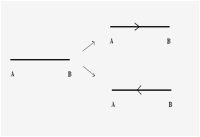Modeling visuomotor dynamics of copying
The objective of this work is to study visuomotor dynamics underlying copying simple line diagrams.
A novel viewpoint which was the starting point to this work is the idea that there is an inherent ambiguity in copying as illustrated below. Inherent Ambiguity in Copying: A given line AB can be drawn in two possible directions (from A to B or B to A) (b). Ambiguity can be ameliorated by coupling orientation with direction, but ambiguity cannot be avoided at least at one orientation. Even when all lines are drawn in top-down direction, there is a conflict at the horizontal line, which can be drawn in two possible (opposite) directions.
This ambiguity seems to have dynamical consequences to copying performance, particularly when copying simple oriented lines. We present a phase-dynamic model of copying that explains several dynamic effects that arise while copying oriented lines.
- Dubey, S., Sambaraju, S., Chautha, S.C., Arya, V., Chakravarthy, V.S., A phase dynamic model of systematic error in simple copying tasks. Biological Cybernetics, 2009 Sep;101(3):201-13.
- Saguna Dubey, Sandeep Sambaraju , Sarat C. Cautha, A. Parthasarathy, N. Srivastava, V. S. Chakravarthy, On the role of ambiguity in copying oriented line diagrams, International Journal of Brain, Mind and Cognition, Vol. 1, No. 2, Jul--Dec 2010.


